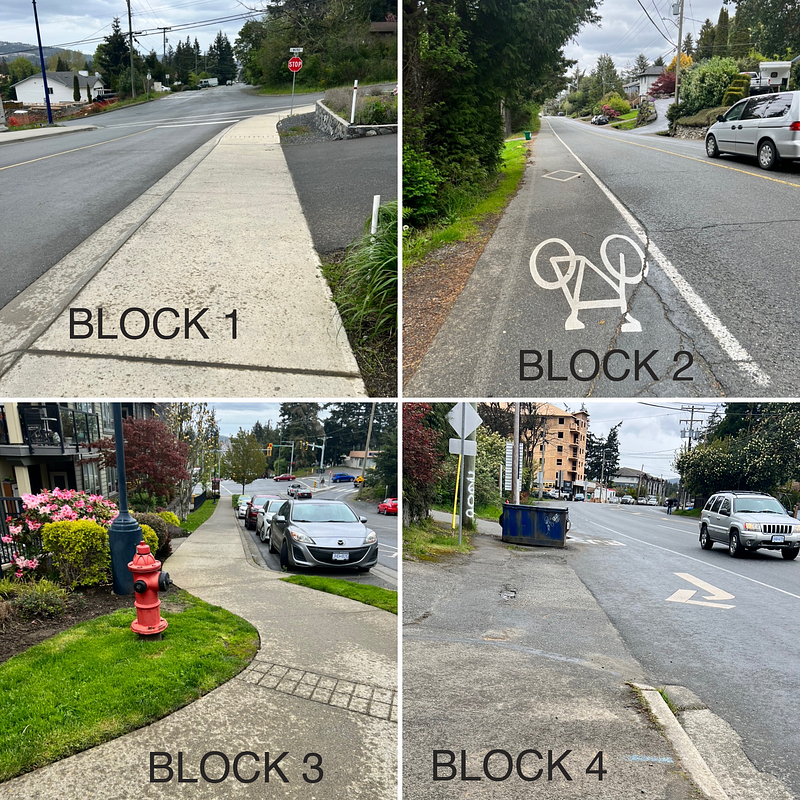What do sidewalks and Service Design have in common?
Infrastructure woes show us the importance of having joined up government services

When I walk my 3 year old to his nursery in the stroller, the journey is divided into 4 parts — let’s call them blocks.
- Block 1: Sidewalk. It’s safe and it’s usually clear (except on rubbish day)
- Block 2: No sidewalk. Busy-ish street, but it has a bike lane so as long as there are no cyclists it feels ok
- Block 3: Sidewalk, nice and wide with flowers and fountains. The best/easiest part of the walk
- Block 4: No sidewalk. You can’t tell from this photo but this is an extremely busy highway, and there’s not even much of a shoulder on the road. I have to walk into oncoming rush hour traffic in the mornings. The terrain is gravelly and there’s a big rubbish dumpster that blocks my path.
Not surprisingly, I don’t feel safe walking to the nursery.
Why isn’t walking safer?
I’ve complained to my local government about this walk and these are the points they come back to me with:
- The housing / land developers (private companies) are required to build sidewalks for their particular development, which is why there are nice sidewalks on Block 1 and Block 3. But there’s no requirement or even a compelling reason for them to spend money to build sidewalks elsewhere to connect the community.
- Block 2 is the local gov’s responsibility but they (allegedly) can’t build a sidewalk because most of the land is private property
- Block 4 is not their problem because it’s owned by a different level of government so I’d have to contact them (I did but they didn’t respond)
The thing is, I just want a safe way to walk my child to his nursery. I don’t care who owns the land or who’s responsible for what. And I shouldn’t need to know or care. Travelling around the neighbourhood I live in shouldn’t be political.
But … what do sidewalks have to do with service design?
A person using a government service shouldn’t need to know who owns what, or what rules there are behind the scenes. They should be able to get to point A to point B without having to take a crash course on government responsibility models.
Services, like sidewalks, should be joined up. They should take you from one part of the journey to the next in a safe and logical way, and you shouldn’t need to know who owns what. They should look and feel the same throughout, and have clear markings to keep you on your path. They should make you feel confident that you’ll reach your destination.
How can we apply this to service design?
Product teams are like the private land developers: they’re only looking at the part of the journey they are responsible for. They don’t have the time, money or mandate to look at where their users are coming from or going to.
This needs to change. But as someone who’s always been on product teams and never responsible for the bigger picture, I’ll admit that I’m not really sure how.
I suspect it starts with organizational change: Structuring our teams not around business functions or levels or even physical territories, but around outcomes for citizens. Breaking down silos is such a cliche in government, but it’s really what this is all about. If an end-to-end service spans multiple departments, divisions or even governments, it should be a requirement that these different groups will work together in a meaningful, continual way, to create consistency and fill the gaps in between. The service users shouldn’t have to pay the price of government departments and businesses not collaborating.
We need to stop passing the buck and drawing lines in the sand. Every public servant, department and division has to take collective responsibility for the outcomes for our end users by working together across jurisdictions, even when it’s “out of scope”
It starts with service design, but we designers can’t do it on our own. We need our leaders to champion this way of thinking and working, to better set us up to collaborate, and to take responsibility for the gaps.
The cost of bad services and sidewalks are immense
The walk to the nursery doesn’t feel safe, so I drive.
This costs me money, it’s bad for the environment, it’s bad for my health, and it means I have less connection to my community because there’s no chance of catching up with a neighbour when you’re in a vehicle.
I see “cars” used to navigate bad government services all the time: hiring an accountant because you can’t figure out the basic tax forms, or paying high fees to an immigration lawyer because the costs of getting it wrong are too high.
But “cars” are only available to those who can afford them. Everyone else has to walk down the highway and hope they don’t get hit by a truck.
Bad public services, like bad sidewalks, show us that the government cares more about certain types of people (drivers) than others (pedestrians.) And when governments exist to serve everyone equally, that’s just not acceptable.
So how do we make sidewalks better?
I don’t have answers for this — but here’s a thought experiment:
- What if, instead of the responsibility of sidewalks being chopped up across different entities that don’t work together, there was a product team or program that focused on pedestrian infrastructure for the whole province and worked across local gov/provincial gov/private sector? And what if those people and teams didn’t report to a specific ministry or org, but to the service program as a whole, one that was focused on outcomes for citizens?
- What if there were user researchers (lots of them, not just 1 or 2) who were front and centre at all the meetings on sidewalks, who shared the stories of real people who use the sidewalks?
- What if there were leaders and politicians who spent more time listening to this research, and made their decisions based on user needs?
- What if design and research were part of the early policy and planning stages of services, rather than brought in at the last minute to fill the gaps and make it look nice?
- What if, most crucially, we (governments at all levels) gave power to the people in the community to design the infrastructure and public services that worked for them? What if we built everything to fit how they do things, instead of expecting them to change their behaviour to fit how we do things?
Maybe I’m a dreamer — but if we want better outcomes for pedestrians and people everywhere, we have to be willing to radically change how we do things.


Comments ()